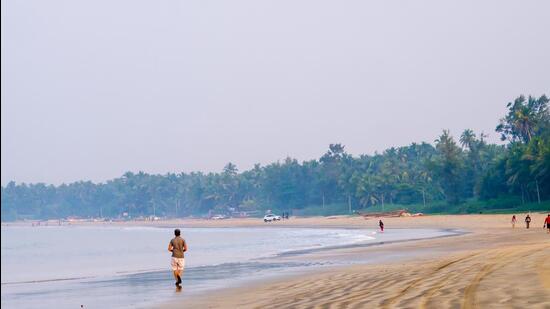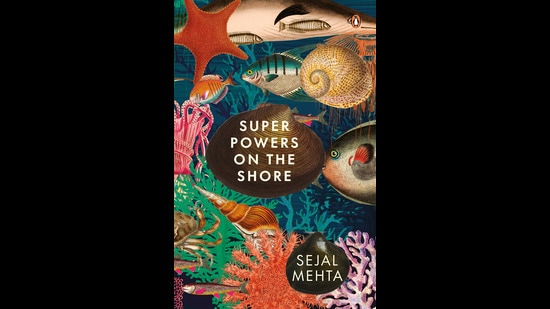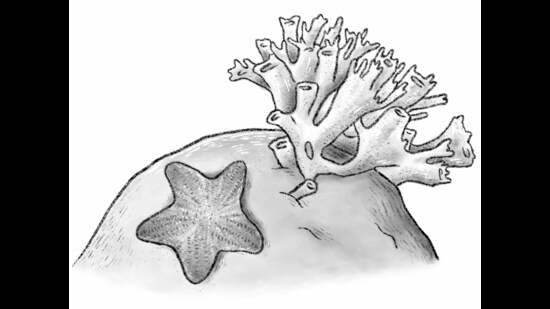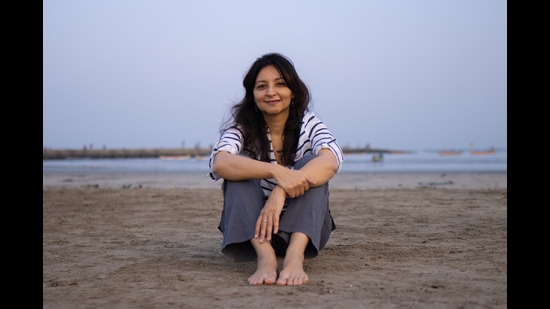Excerpt: Superpowers on the Shore by Sejal Mehta
In this extract from a book on the creatures that populate India’s intertidal zone, the author ruminates on the things an individual can learn about herself and the world during a walk on the beach
Walking is falling forward. Each step we take is an arrested plunge, a collapse averted, a disaster braked. In this way, to walk becomes an act of faith. We perform it daily: a two-beat miracle—an iambic teetering, a holding on and letting go. For the next seven years I will plummet across the world.

— Paul Salopek, journalist
When you walk somewhere, your entire being is present in the moment. As Salopek said, it is a two-beat miracle. Putting one foot in front of the other literally and figuratively tethers us to the present. While his quest involves a journey of about 33,800 kilometres, and stories and findings about the world we inhabit, closer home, the writer and film-maker Siddharth Agarwal is walking along India’s rivers to document the twists and turns they share with people. In West Bengal, two marathon runners, Avisek Tunga and Debabrata Ghosh, ran along the 55-kilometre intertidal region from Bankitput to Digha, in a campaign to raise awareness about the coastline. They ran over the wet sand, waded across river systems, spoke to fishers and saw a wild intertidal zone at dawn.
I never really thought that the simple act of walking on a shore can be this vital.
In Mumbai, Gopal MS, called “Slogan Murugan” and “Mumbai Paused” on social media, is a city documenter. He started to capture the city in photographs, not to any end, but to make sense of where he lived, and gradually to record what it meant. The slowest form of photography, he said, was to sit in one spot while the action happened around you. Conversation happens when you stop, stay and sit, when you exchange food or water and stories. The next is walking. When you walk, you are able to observe things, people and moments.

What do you see when you walk? On a beach, this might mean watching the sand, or the cute candy crush-like umbonium sea snails — pink, chocolate brown, peach or maroon — doing what appears like backflips when disturbed. Or it could mean looking up at the catch the fisher’s pulled in. Or it could mean looking at the houses that overlook the beaches, with balconies that promise sunsets accompanied with tea. Or the houses that fall close to the gradually advancing high tideline, now within buffeting range of the monsoon storms. Or the woman bent over the rocks with a sickle breaking open oysters (or kalva as we say in Marathi). On the Lakshadweep islands, it could mean a community, social interaction for women as they hunt octopuses in ankle-deep water. On tourist shores across the world, it could mean watching the evening rush, people talking over video calls, showing their loved ones back home the magnificent ocean. Or it might mean spotting the candy sellers and the balloon sellers. The beach is a place of leisure, it is a place of business, it is a place of livelihood and it is a home. And it is different from shore to shore.
Siddharth Chakravarty, one of the initial founders of Marine Life in Mumbai, before he left to study and understand coastal policies, is a strong advocate for learning through conversation — and in the simplest of ways. He had gone for a run at a beach in West Bengal, and noticed some glistening shapes at the water’s edge. Closer inspection revealed heaps and heaps of stranded box jellyfish. He struck up a conversation with a fisher who referred to them as telfotka, which translates to ‘oil droplet’ because of the creature’s appearance. “They become like oil and clog up the nets,” the fisher said, “so we’re not fishing right now”. Siddharth asked him when he would be able to fish again, and he replied, “When the wind changes direction. When it blows these animals away, we can take the boats out again.” He was surprised because this usually never happens in February, “so something is up with the weather”. What a simple conversation and yet so much said about people and the intertidal zone, climate change and history.
Historian Sandeep Dahisarkar writes about a walking ground that has impacted history in a piece titled Of Kings and Coconuts and Juhu’s First Family. He writes about walks on Juhu beach taken by none other than Mahatma Gandhi, who was known to frequent its sandy tidelines when he lived in the city in the 1900s. It also went on to be a significant ally of sorts during the salt satyagraha. Between 1899 and 1904, while under the British rule, Juhu was the site of an interesting plan by Jamsetji Tata. He planned to criss-cross the islands and mudflats with canals. Historian RM Lala writes about it in his book, For the Love of India: The Life and Times of Jamsetji Tata. The plan was to use 1,200 acres of the shore and demarcate it into canals and plots, so the tide could play a role in the water supply. The idea, which came to be known as the ‘Venice Scheme’, never did take root due to differences in opinions from landowners.
You might drive along shores, snorkel in the shallows and dive in the deep and you’ll learn different things, past and present. One day, when the sea had retreated farther inside (which it does during an extremely low tide) I walked onto the sandy section of Juhu beach, a shore I thought I knew so well, to see tiny plateaus rising out of the water. This is the part of the beach where large boulders are usually hidden from sight underwater. These were revealed on the lowest of tides. I watched as people walked on the boulders, accidentally tidepooling, watching crabs, eels, and watching fisherwomen collect clams — all of this right on the most crowded, touristy part of the beach.

Walking along an intertidal zone is also the act of being able to walk up to a sea creature and stay with it until the tide returns. Once, on a late evening in Juhu, we saw a live sea fan (a type of soft coral) anchored in the sand when the light had already left. It was like something I’d only seen in documentaries, or like the dead ones that wash onto the beach. Under the torchlight, it seemed to exist in another galaxy, the water particles like tiny stars lit around it. To be able to walk up to this strange animal that looks every bit like a tiny tree but is very much an animal, and then sit with it at leisure with a macro lens and observe the tiniest skeleton shrimps (as large as one-third of my fingernail) perched on it — that’s powerful, isn’t it? Because you’d usually see sea fans just in the deep. Ram Vilas Ghosh, a researcher who has been working on these animals for four years, was gobsmacked when he came across them in Maharashtra’s intertidal zone. ‘They usually need pristine water, what are they doing in Mumbai?’ he said, delighted. He remembers a conversation with fishers in Tamil Nadu. They’d caught a gorgonian sea fan in their net, and were ignoring it because they assumed, like everyone does, that it’s a plant. Ghosh smiled and said:
When a sea fan is submerged in water, you can see its real power. . . . It literally blossoms and those colours are just incredible. I took it to the water and showed them that this was a sea creature, not a plant and their excitement and wonder was palpable. This changed their view entirely for future sightings. This is why we must walk, must work with people and exchange our learnings [sic].
Yes, empathy is a valuable characteristic — the more you walk, the more careful you are with marine life on the shores. Photographers, if you feel the need to move your subject around simply because you can, for ‘that’ particular photograph, hone your craft and do better. We have to realize that our interest in them and the way we engage with them could cost them energy, or worse, a predatory attack. They are in the middle of their day when I am watching them. If they are in the middle of a hunt or being hunted, any carelessness from me could cost them either a meal or their lives. Leave things as they are, and don’t carry things home; everything gets used up, even homes. On a shore in Karwar, I saw a whole patch of rocks covered with honeycomb-like tubes — and the name fit. They were homes made by the honeycomb worm, but after its death, it inadvertently leaves a network of homes for so many more things.
The sign of a superpower is that it empowers others.
And your mind starts to think more inclusively about the definition of what it means. When we think of wildlife, we often only think of pristine forests and protected areas. This fraction alone cannot, and does not, support all wildlife. We need to expand our lens beyond areas that are protected by law. Wild animals do not recognize administrative boundaries. Many of these habitats — not just forests, but deserts, grasslands, wetlands and coasts — are vital for humans and wildlife alike, whether they belong in urban, semiurban or rural areas. All of this needs our respect and empathy, not just protected areas. It just reiterates that wilderness is only where a wild animal stays, not a boundary that we get to set.
It’s truer than ever for a coast, isn’t it? In 2019, I was in Malvan to listen to dolphins. I was on an assignment for Mongabay India, to write about Isha Bopardikar’s research on understanding dolphin behaviour through acoustic data under the Rufford Foundation’s ‘Small Grant for Nature Conservation’. Acoustic research uses sound to study subjects; bioacoustics tucks biology into that fold. Simply put, it is used to listen, and understand their communication and behaviour. Under the water, early-morning bulletins were already underway; we just weren’t invited to the conversation. But humans have been gate crashing wildlife parties for centuries, so there we were, waiting to eavesdrop on the latest news. It reiterated how little we actually hear, despite the constant cacophony around us. Whether it is bats in the skies or this entire civilization under the water, so many creatures communicate through mediums and frequencies humans are categorically excluded from.
And just like in the shallows and the deep, life and sound unfolds at Malvan’s shore. It is a sensory splash: cars, bikes, horses, horse carts, water sports vehicles, boats, fishing boats, fish auctions, ice factories, crates, and every single thing surviving at the water’s edge. Plus, there is the contribution of a bustling intertidal zone.
All in the same place.
Our residence was a small, two-storied house with rooms dedicated to researchers staying for months on end, cooking their meals, poring over data sheets, and prepping for field day (which means a day out in the field, and not necessarily a fabulous day). On the mornings when we’d visit the beach, we would step out right on to the beach with a cup of tea, something a Mumbai girl does not take lightly, and would meet the absolutely bizarre Arabian tibia, a sea snail that if you see up-close looks like it has a trunk. The fringed sea star (Astropecten indicus) spread out and wriggled its way in and out of the sand, and the occasional sea snake was waiting for the water to wash it back in.
Research suggests that the negative ions around the shores actually help our bodies feel better. A forest’s embrace is a comforting thing, as is the ocean’s reliable presence. The flowers and the earth are fragrant. The beach is fragrant too; when Kramer wanted to bottle the smell of the beach in Seinfeld, he was really on to something. Memories are such a sensory experience. If I think of the shore, I automatically smell the salt, the slightly humid feeling, sulphur, and yes, even poop.

Of all the things strange and wonderful about scientists, their capacity to discuss poop is remarkable. Leopard scat, tiger scat, elephant dung — the list is endless. While on a writing assignment on otters, I am certain there was lots of pointing and laughing from the river as we sat around their poop to understand their dietary habits. As a tidepooler (someone who actively looks into tide pools for intertidal animals), unfortunately, you might have to add human poop to that list.
But what does your body do when it walks repeatedly on a shore? It understands. On a sandy beach, it relaxes, and it is almost playful. On a muddy one, it anticipates the squelching, knows you might sink several inches into the muck, and it prepares for it. Go to a rocky shore, and your body tenses, anticipating an undulating climb. There are slippery boulders and sharp barnacles — your body moves to protect you from hurting yourself. All your senses are present. Ah, don’t step on those shells, don’t hurt the shrimps — your body’s memory avoids stomping across the tide pools just because they promise flatter ground. After four years, I am proof that a body not only sees, but also remembers.
Walking is meditative and introspective. It is the best teacher we have about ourselves, and the concept of change. Walking leads to new perspectives. Various conversations reveal small truths about the city and the shore. Each conversation is like a piece in a large jigsaw. With every piece, one more thing about your backyard clicks into place.
All Access.
One Subscription.
Get 360° coverage—from daily headlines
to 100 year archives.



HT App & Website







